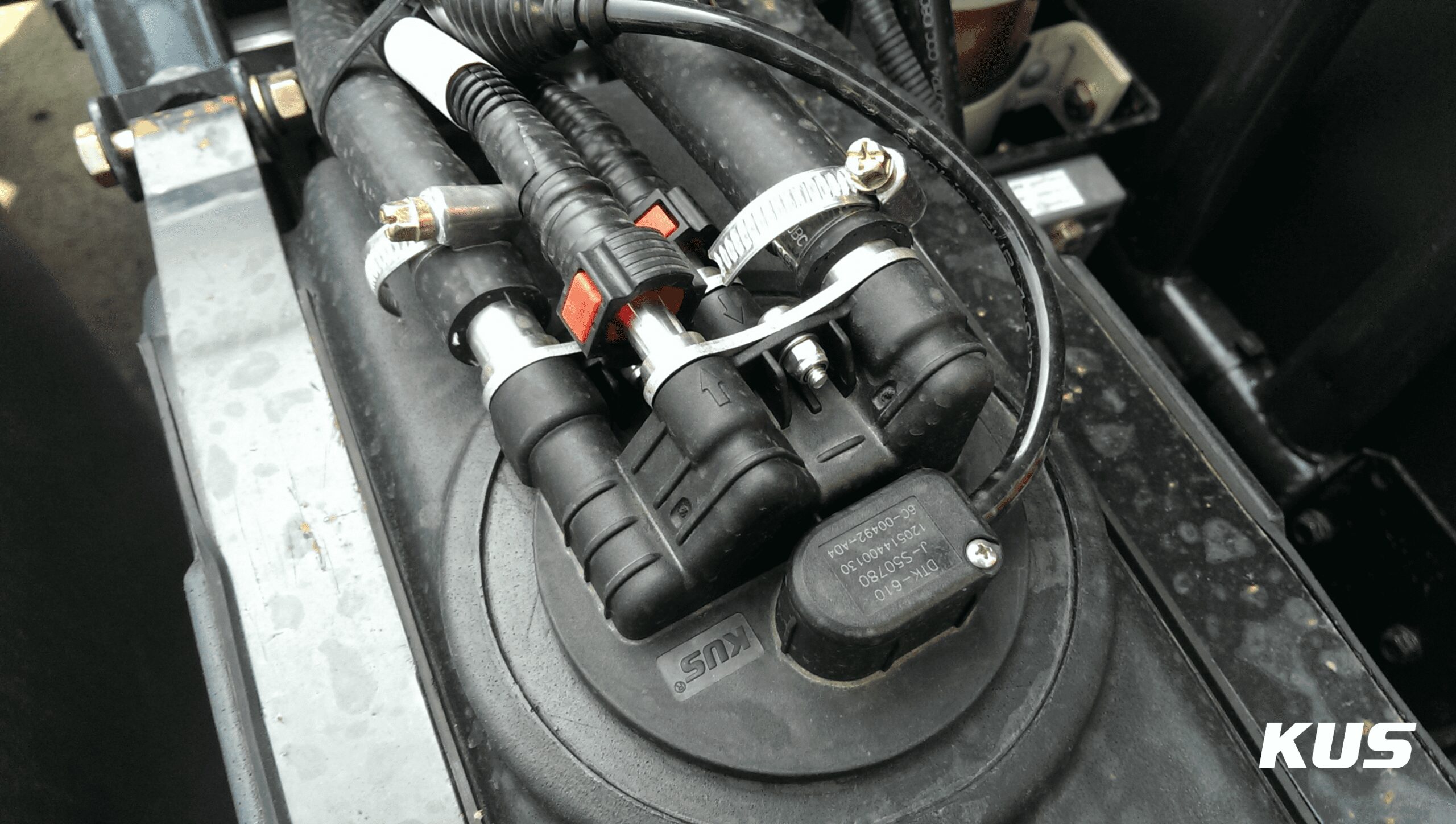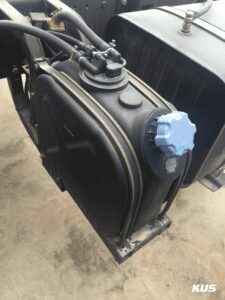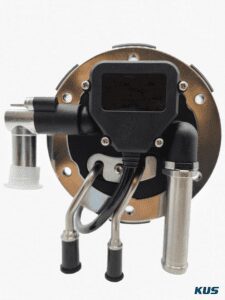
Diesel exhaust fluid (DEF) is a non-hazardous solution used within a selective catalytic reduction (SCR) system to break down harmful pollutants (NOx) generated by a diesel engine. DEF is 32.5% urea, or aqueous ammonia solution, and 67.5% deionized water. The fluid is sprayed and then spread into the exhaust gas via a mixer before entering the SCR catalyst.
As DEF enters the SCR catalyst, it evaporates into ammonia (NH3) and water (H20). The NH3 sticks on the SCR catalyst and binds with the nitrogen oxides (NOx) as they pass over the catalyst. Once bound, the NOx combines with the NH3 to create a chemical reaction resulting in nitrogen and water. This process reduces harmful emissions and increases fuel efficiency.
In the U.S., all heavy and medium duty diesel truck engines produced after January 1, 2010 must meet the latest EPA emission standards. This is accomplished through the use of an aftertreatment system, which frequently includes SCR technology that utilizes DEF. In addition, all DEF solutions and products must meet the ISO 22241 standard to ensure effectiveness.
Essential DEF Components for Your SCR System
There are three major components in any SCR system. These include a DEF supply module or injector, a DEF tank assembly, and an SCR catalyst. Since 2003, KUS has been working with global exhaust aftertreatment system integrators — and vehicle and engine OEMs — to design and manufacture components for the SCR system in accordance with ISO 22241 standards.
KUS’ line of DEF products focuses on NOx conversion. They include DEF tanks, DEF sending units, DEF nozzles, DEF tank caps, DEF filler neck, and other accessories. KUS is unique because we manufacture and handle the whole EF tank assembly in-house. This means we are able to engineer, design, and validate both products concurrently, reducing lead time and compatibility issues.
Let’s take a closer look at what makes DEF tanks and DEF sensors so important.
What You Need to Know About DEF Tanks
Although diesel exhaust fluid is nontoxic, nonflammable, and safe to handle, it is corrosive against some metals. Because of this, diesel exhaust fluid must be stored in a special tank (DEF tank) on board the vehicle. The diesel exhaust fluid (DEF) tank is typically located behind the cab, next to the diesel fuel tank. Most DEF tanks are made of high-density polyethylene (HDPE), and are identifiable by their light blue caps.
DEF cannot be stored in containers made of carbon steel, copper, or alloys that contain copper or zinc-coated steels. Improper DEF storage can lead to contamination and compromise the SCR system. DEF’s shelf life is about two years when properly stored at an optimal temperature of around 75 to 77 degrees Fahrenheit. However, if DEF is exposed to direct sunlight — or a temperature above 86 degrees Fahrenheit — for a sustained period of time then the fluid can degrade faster than it normally would. Freezing or thawing of DEF will not cause degradation of the product. The production date of your fluid should be visible on the original packaging.
Similar to DEF itself, you should always look for DEF products that are made to the ISO 22241 standards, such as KUS’ DEF Tanks. Products that do not meet this standard may cause issues or failures with your emissions system.
How Do I Know If My DEF Tank is Close to Empty?
The Environmental Protection Agency (EPA) requires all diesel engine manufacturers to integrate some sort of tiered warning system, consisting of internal gauges on the dash, to let the vehicle driver know exactly how close to empty the DEF tank is. When the DEF tank level drops below 10% a warning light will activate. At 5% this lamp starts flashing and at 2.5% the light will be a solid amber. If the truck completely runs out of DEF, then the vehicle speed reduces to 5 mph until the tank is refilled. It’s important to note that not all OEMs follow this method.
The DEF level sensor, which is part of the DEF sending unit, measures the level of fluid remaining in the DEF tank. When the liquid level is low, the DEF level sensor sends a signal to the vehicle’s ECU which then triggers the warning light on the gauges or panel. However, the DEF sending unit typically has more functionality than just liquid level measurement. Let’s take a closer look at how it works.

What You Need to Know About DEF Senders
The DEF sending unit mounts to the DEF tank. It integrates liquid level and temperature measurement functions, and it also regulates DEF temperature via a heating function that utilizes the engine’s coolant. A urea quality sensor is integrated into the DEF sender to measure DEF concentration. All of these components work together to ensure SCR system efficiency.
While all DEF sending units perform the same essential functions, there are a few customization options that can help increase the performance of the unit based on your usage. These include mounting head options, heating tube body forms, and the type of DEF quality sensor used.

Mounting Head Options
KUS offers three different mounting head options for its DEF sending units. They include:
- Bayonet Mounts, which use a bayonet head that connects to a matching opening and is twisted into place and sealed with an o-ring. It is a versatile mounting option.
- Rubber Head Mounts, which were originally designed for a narrow DEF tank that has a small installation area. These have since become popular with OEMs for mounting DEF senders to all types of DEF tanks due to their ease of installation and sealability.
- Flange and Bolt Mounts, which use bolts or screws for mounting by the flange. This mounting method doesn’t require any specialized installation tools making it an easy choice for those who need a quick and easy installation.
KUS has decades of experience working with vehicle OEMs, tank manufacturers, and aftertreatment system integrators to find the right mounting head option for the job.
Heating Tube Body Forms
KUS produces five different heating tube body forms that utilize the engine’s coolant to heat cold DEF or thaw frozen DEF to the optimal temperature. These include the following forms:
- Coil
- L-shape
- Paperclip
- Combination
- No Heating
The heating tube body form you choose will depend on the climate in which you operate and the shape and size of the DEF tank. In regions where the climate does not get cool enough for DEF to freeze there is no need for heating coils. KUS can help with selecting the right heating tube body form for your use case.
DEF Quality Sensor
All of KUS’ DEF sending units are designed to work with our Ultrasonic Quality Sensor, which accurately monitors DEF concentration and quality. The quality sensor alerts the user if the solution deviates from the acceptable concentration range or if there are any contaminants present in the DEF tank. DEF concentration directly influences SCR system performance.
Not all units come with DEF quality sensors, the DEF Quality Sensor is an optional add-on depending on application. Emission regulations mandate that vehicles must have quality sensors.
KUS: Your One-Stop-Shop for DEF Tanks and Senders
As previously mentioned, KUS is unique because we manufacture and handle the whole DEF tank assembly in-house. Working with one manufacturer for these parts prevents delays. KUS’ engineering and design teams have more than 10 years of experience designing custom DEF tank and total tank assemblies for SCR system integrators, and vehicle and engine OEMs.
In addition to its custom solutions, KUS also offers standard, ready-to-market DEF Total Tank Assemblies ranging from 16L to 80L. This provides our customers with a variety of options. View our main DEF product offerings in our online shop or contact us for more information.
